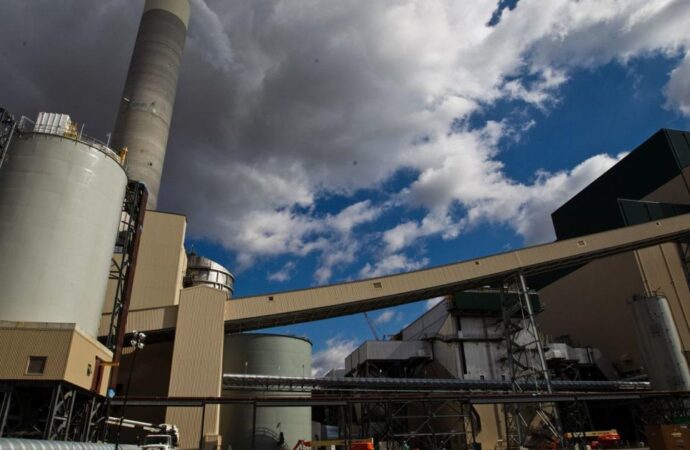Illinois, one of the nation’s largest producers of coal, is on the verge of becoming the first Midwest state to ban energy companies from burning the lung-damaging, climate-changing fossil fuel to generate electricity. The end of gas-fired power might not be far behind. Phasing out the combustion fuels — coal by 2035 and gas a
Illinois, one of the nation’s largest producers of coal, is on the verge of becoming the first Midwest state to ban energy companies from burning the lung-damaging, climate-changing fossil fuel to generate electricity.
The end of gas-fired power might not be far behind.
Phasing out the combustion fuels — coal by 2035 and gas a decade later — is a key element of Gov. J.B. Pritzker’s plans to move Illinois into a clean energy future. If the Chicago Democrat can muscle his legislation through the General Assembly this week, new government requirements would speed up a transition to climate-friendly electric generation and transportation that already is embraced by some in the private sector.
Among other things, the bill would double the state’s commitment to renewable energy, with a goal of raising the amount of wind and solar power to 40% of the state’s electric generation by the end of the decade, up from 8% in 2019.
Several hurdles remain, in particular opposition from five Chicago suburbs and dozens of Downstate communities that during the mid-2000s agreed to help pay off more than $5 billion in debt for the Prairie State Generating Station — one of the Top 10 industrial sources of heat-trapping carbon dioxide in the United States.
Municipal investors in the massive coal burner, including Batavia, Geneva, Naperville, St. Charles and Winnetka, want Prairie State exempted from the governor’s fossil fuel phaseout. So does Springfield, which built a new coal plant around the same time even as private investors abandoned dozens of similar projects, scared off by skyrocketing construction costs and the likelihood that climate pollution would eventually be regulated.
A group of 52 state lawmakers sent Pritzker a letter during the weekend claiming that closing Prairie State and Springfield’s Dallman coal plant would make the electric grid less reliable. But the governor is adamant that the rest of Illinois should not pay for bad financial bets made by a handful of communities.
“Remember natural gas would stay online till 2045,” Deputy Gov. Christian Mitchell said during an interview Friday. “We recognize that … having some baseload power that is at least less bad than coal is going to be necessary to get us (to a carbon-free future). But the idea that we need to keep coal plants online forever just doesn’t hunt.”
Coal-fired power plants once provided more than half of the state’s electricity but are rapidly disappearing as energy markets squeeze out aging generators in favor of cheaper, cleaner gas and pollution-free wind and solar power.
Outlawing what’s left of the Illinois coal fleet would dramatically reduce the state’s contributions to smog- and soot-forming pollution that triggers asthma attacks and takes years off of people’s lives.
Environmental controls at the power plant on the new Prairie State Energy Campus near Marissa, Illinois, in 2011.
It also would erase Illinois from the list of top U.S. climate polluters. Prairie State alone is responsible for more than a quarter of the greenhouse gases emitted by the state’s power sector, according to federal records.
“If Prairie State operates indefinitely with an exemption from climate targets, it will derail any meaningful plan for climate action in the state and the nation,” said J.C. Kibbey, a clean-air advocate for the nonprofit Natural Resources Defense Council.
Another fiercely debated provision in Pritzker’s energy bill would pay Chicago-based Exelon nearly $700 million during the next five years to keep its Braidwood, Byron and Dresden nuclear plants open.
Commonwealth Edison’s parent company already gets up to $235 million a year in subsidies for its Quad Cities and Clinton nuclear plants. The possibility of another bailout doesn’t sit well with some legislators, who oppose charging ratepayers again to benefit Exelon after ComEd admitted in federal court that it engaged in a yearslong bribery scheme to advance the company’s agenda in Springfield.
New subsidies would cost the average residential power customer about 80 cents a month, according to a memo drafted by Pritzker’s aides.
The energy legislation also would require residential power customers to pay $1.22 a month to subsidize renewable energy development, and another 86 cents a month to expand home-weatherizing programs for low-income customers.
From a health and climate perspective, keeping the state’s carbon-free nuclear plants open for at least a few more years would help block new gas-fired generation and stabilize the grid as more wind and solar power comes online.
New York illustrates how clean energy goals can be upended when existing nukes are taken offline. The Indian Point nuclear plant once provided more electricity than all of the wind turbines and solar panels in the state combined. After it closed in April, most of the electricity it generated was replaced by gas plants, federal records show.
Meanwhile, a recent study by Harvard University researchers found that a shift away from coal in Illinois during the past decade saved thousands of lives and dramatically reduced health impacts from breathing particulate matter, commonly known as soot. But the numbers declined only slightly for gas, which by 2017 accounted for the greatest health risks.
The Prairie State Energy Campus near Marissa, Illinois, in 2013.
Pritzker already compromised on his target to phase out coal, giving Prairie State, Dallman and three plants owned by NRG Energy five more years to operate beyond the 2030 deadline in an earlier draft of the energy legislation. The latest version would enforce increasingly stringent caps on the amount of carbon dioxide allowed from fossil fuel plants, mirroring President Joe Biden’s plan to shutter all U.S. coal plants by 2035.
Researchers say the federal and state goals would be relatively easy to achieve, albeit with a few exceptions.
“Folks, we’re in a crisis,” Biden said while introducing his climate team. “Just like we need to be a unified nation to respond to COVID-19, we need a unified national response to climate change.”
Naperville and Winnetka belong to a municipal electric association that will have paid off its share of the Prairie State debt by then. Brian Groth, Naperville’s electric utility director, said in an email the city supports “a long-term path to clean energy” but has concerns that “early retirement of Prairie State would have significant impact on the rates for our customers.”
Other cities are on the hook for several more years, and some have suggested that state or federal lawmakers should bail them out.
The investment was deeply troubled even before the suburbs and scores of other Midwestern cities signed contracts with Peabody Energy, the coal company behind the project. Prairie State and an adjacent mine ended up costing more than twice the initial price tag, forcing many of the cities, towns and villages to raise electric rates and, in some cases, local taxes.
Peabody later sold its 5% stake in the coal plant for a fraction of what it spent to help build it. But some of the municipal investors are still paying more than twice the cost of electricity on the open market.
In their letter to Pritzker, lawmakers who back Prairie State and Dallman, most of whom are in the Republican minority, argued the coal plants are a “bridge to a cleaner, more stable energy future.”
“Communities that rely on these sources of power will face new financial burdens as they are forced to find replacement sources of power in short order, which will not only impact municipal budgets but will often be passed along to consumers in the form of higher utility bills and higher taxes,” the lawmakers wrote, echoing statements from municipal electric agencies.
The most they’ve gotten out of Pritzker so far is a provision that would set aside $2 million a year to decommission Prairie State. The bill also would create a task force to study refinancing options and the possibility of retrofitting the coal plant to inject carbon dioxide deep underground — an option that could reduce atmospheric emissions but would make Prairie State even more expensive to operate and demand a significant share of the electricity it generates.
“Illinois has a recognizable opportunity to serve as a leader in growing a carbon capture economy,” the plant’s legislative backers wrote.
If recent history is any guide, though, carbon capture and sequestration is a political buzzword rather than a realistic solution.
The U.S. Department of Energy twice pulled the plug on plans to convert a former Illinois coal plant into a showcase for the technology billed as FutureGen. After spending $7.5 billion on a new fossil fuel plant equipped with the technology in Mississippi, Atlanta-based Southern Co. abandoned the use of coal and the equipment to capture carbon emissions, turning the Kemper County Energy Facility into a very expensive gas-fired plant.
Based on the cost to operate a Canadian coal plant with the technology and a similar plant now closed in Texas, adding carbon capture to Prairie State would increase electric bills by at least half and as much as 400%, said Kibbey, the NRDC advocate.
“These communities are in a hole and need to stop digging,” Kibbey said.
Left unaddressed in Pritzker’s legislation are the health and climate impacts of coal mined in Illinois.
Only three other states produce more of the fossil fuel. Though little of it stays in Illinois, the amount burned elsewhere released more than 82 million tons of carbon dioxide into the atmosphere during 2019 alone, according to a formula developed by the U.S. Environmental Protection Agency.
The staggering amount of climate-changing pollution is equivalent to more than three years of emissions from all 4.6 million automobiles registered in Illinois.
Illinois’ most endangered historic places
Broadview Hotel, East St. Louis
Built in 1927, the hotel, which has fallen into disrepair, could be used as more than 100 housing units for seniors, Landmarks Illinois said, but the hotel needs an act of the Illinois General Assembly to expand a tax credit for the redevelopment.
Joliet Steel Mill main office building, Joliet
A 130-year-old part of the Joliet Steel Works National Register Historic District, the building has been neglected by U.S. Steel, which still owns the structure, Landmarks Illinois says. Productive discussions between U.S. Steel, which still owns the building, and the city are recently underway, McDonald said.
Klas Restaurant, Cicero
Vacant and up for sale, with no historical protection, the Cermak Road building long served as an anchor of Czech culture in the region since it was constructed in 1922, the group said.
The owner received a demolition permit from the city that has since expired, according to McDonald. A new buyer who can rehab the building and restore artistic features, including indoor murals, is being sought.
Havana Water Tower, Havan
Built in 1889, the National Register-listed water tower needs extensive rehab work from top to bottom, the group says. The city does not have funding for the extensive repairs and the site continues to deteriorate.
Illinois Terminal Interurban Station, Decatur
A building that was first a rail station, then a church, the structure’s current owners, the Faith Community Assembly, expect to sell the 1931 building, Landmark Illinois said.
Altgeld Gardens Shop Building and school buildings C and E, Chicago
Known as the “Up-Top,” the wavy-roofed retail building in the Chicago Housing Authority’s Altgeld Gardens housing complex is privately owned and in demolition court, according to Landmarks Illinois. The building, built during World War II, hosts a painted memorial wall for those who died of pollution-related illness and violence.
Neighborhood residents have told Landmarks Illinois they hope the “Up-Top” will be converted into a grocery store.
James R. Thompson Center, Chicago
Long on the endangered list, the Thompson Center appears to be having its sale hurried along by the state’s COVID-19-exacerbated budget shortfall in 2020. April 2, 2022, is the targeted sale date.
‘Green Book’ sites statewide
A contemporary Underground Railroad of sorts, many “Green Book” sites are often unassuming private homes or buildings that catered to Black travelers. Many have already been lost to demolition or redevelopment, and any number of structures could suffer the same fate without owners even knowing of their historic significance. The group is working with Route History to document the history of “Green Book” sites along Illinois’ historic Route 66, but seeks a larger-scale documentation and preservation effort.
Scott Foresman headquarters, Glenview
Itself a textbook example of midcentury modern design, the 1966 textbook publishing corporate campus is a type of structure that is particularly vulnerable, preservationists say, as many companies downsize their office holdings. Lots were already leaving office campuses in the suburbs in favor of new downtown locations before COVID-19 struck.
Preservationists suggest it could be re-purposed as a school, daycare campus or fitness center.



























Leave a Comment
Your email address will not be published. Required fields are marked with *